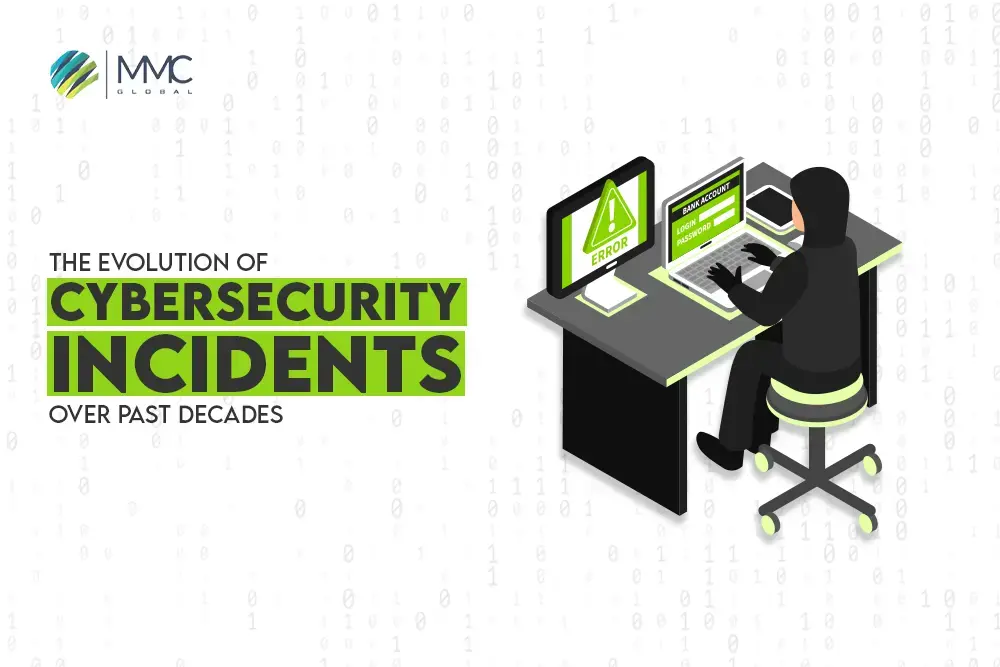The Evolution of Cybersecurity Incidents Over Past Decades


With the emerging innovation in the IT sector, the evolution of cybersecurity incidents and cyber threats must be noticed. As far as technology obtains the progressive approach, hackers are also empowered with futuristic hacking techniques. These techniques promote more malicious activities, scams, and evolving cyber threats.
AI is one of the prevalent technologies that hackers use unethically to exploit end users or organizational data. However, these new avenues for hackers make them more robust to hack systems, network infrastructures, and applications. In this blog, we will unveil the evolving risk of cybersecurity incidents by analyzing traditional to modern techniques. Moreover, we also cover how to protect from them before becoming more threatening for individuals and organizations.
The Evolution of Cybersecurity Incidents
Before we indulge in the history of cybersecurity incidents over decades, I would like to explain cybersecurity incidents from scratch. Cybersecurity incidents refer to undesirable and unfavorable events emerging from the hackers’ sides to get control over critical information and unauthorized accessibility of digital systems at the organizational level. Moreover, it disrupts the continuity of business operations, manipulates customers’/clients’ data, violates rules, and hurts the organization’s reputation.
According to Harvard University’s research, ransomware attacks have increased up to 150% compared to the past years. Ransomware, phishing, and spamming are the most common cybersecurity incidents many organizations have faced. Due to weak security implementation, small and mid-size companies fall into the hackers’ trap. Let’s dive deeper to understand the evolving cyber threats and the impact of cybersecurity incidents on businesses.
2009-2012 – Rise of Advanced Persistent Threats (APTs)
Advanced persistent threats are long-term cyber attacks that emphasize stealing critical data from a specific endpoint. To initiate the attack, hackers have to work for days, nights, months, and years to gather data.
In 2010, Operation Aurora, the biggest APT attack on Google and other giant companies, enabled hackers to access critical data and intellectual property by exploiting software system vulnerabilities.
How to protect:
Secure VPN – It Protects communication and data exchange between the system and the internet.
Next-Generation Firewall – A next-generation firewall can identify and block malicious traffic, such as APTs.
Intrusion Prevention System (IPS)—This is another system that monitors and responds to APTs to avoid cybersecurity incidents and vulnerabilities.
Threat Intelligence – this is a proactive approach to monitor and predict evolving threats across the globe and update the policies to
2013-2016: Ransomware & Business Email Compromise
From 2013 to 2016, ransomware and business email compromises rose like usual cybersecurity incidents. Again, the focus is on the financial setup. Hackers send spamming emails with social engineering or transfer money to a fraudulent account.
Ransomware is malicious software designed to block access to a computer system or its data until a ransom is paid. BEC is a cybercrime where attackers use email or other electronic communication to trick individuals into transferring money or sensitive information. It often involves impersonating an executive or trusted partner.
How to protect:
Email Filtering – Blocking suspicious emails containing malware or phishing links can help you protect from BEC.
Anti-Malware – Installing anti-malware solutions to monitor or detect email vulnerabilities before encrypting files on your network.
Backup and Recovery—Implementing a backup and recovery policy and solution significantly helps restore data if there is an unusual malware attack.
User Awareness Training—Training your workforce to detect and react to any cyberattack will help you recover potential loss and risk.
Access Control—Integrating your system and network with identified access management solutions will help you prevent unauthorized access to critical information.
2017-2020: Internet of Things (IoT) And Artificial Intelligence
The evolving IoT and artificial intelligence technology are instrumental in building robust intelligent solutions. But hackers also make hay while they are in the sunshine, means they are taking advantage with latest innovation. With AI, engineers can detect anomalies, identify potential threats, and take preventive measures against cybersecurity incidents. On the other hand, AI can also be used to generate threats and launch attacks against the system by gathering dynamic data and information. Moreover, IoT devices are one of the emerging trends for businesses, but due to weak security, they are prime targets of cybersecurity incidents.
In 2017, the Mirai Botnet was a significant cybersecurity incident launched to attack thousands of IoT devices. By utilizing DDoS attacks, it generated unusual traffic from bots over different websites. These botnets also attack all IoT devices, such as CCTV cameras, DVRs, ERP devices, and routers with ordinary security postures. Similarly, in 2018, a DeepLocker named malware was designed to dodge traditional cybersecurity measures by using AI algorithms to hide and remain undetected until it reaches the target.
How to protect:
Network Segmentation – Dividing the network into compact segmentations allows the network to strengthen security and enhance network performance.
Device Management—Adequate device management, including updating device versions, continuous optimization, and routine security checks, helps prevent cybersecurity incidents.
Behavioral Analysis – Implementing AI-powered solutions to detect unusual behavior can help you prevent AI-generated threats and malware.
AI And Machine Learning – With the help of complex algorithms of AI and ML technologies, systems can analyze network traffic and detect anomalies.
2021-2022: Supply Chain Attacks And Ransomware-as-a-Service
Between 2021 and 2022, the supply chain was a significant organization that faced immense cyberattacks—attacking third-party vendors to gain access to their customer network, resulting in potential data loss from vendor companies. In fact, companies that provide software, applications, and cloud service providers are the biggest targets for their supply chain solutions products.
Additionally, RaaS is a business model for hackers, renting out other cybercriminals to launch attacks on targeted points. They deal with some percentage of ransomware profit and identify weak endpoints that can easily be captured by launching a cyberattack.
According to a recent report by SonicWall, the first half of 2021 saw a staggering 304.7 million ransomware attacks, a whopping 151% increase from the same period in 2020. This alarming trend highlights the urgent need for robust cybersecurity measures to protect against these devastating threats.
How to protect:
Vulnerability Scanning – Implementing vulnerability scanning software helps you promptly manage, detect, as well as respond to vulnerabilities.
Access Control—Understanding and implementing the identified access management system should be the first step in mitigating the risk of a cybersecurity incident.
Backup and Recovery – Integrating futuristic defensive systems, Plan B must be ready to include data recovery and instant backups.
Get more info: How Managed Detection and Response Work In Vulnerability Management
2022-Present: Deepfake and Synthetic Identity Fraud
Utilizing AI, we have made a diverse range of facial recognition systems, AI-generated face filters, and other identity-related features, particularly in camera apps and identity recognition systems. Attackers also used this technology to create fake identities using deep fake technology. With this, hackers can create fake images, videos, and voice recordings that humiliate human privacy. In the present era, AI is serving as a two-edged sword that can harm and help you in routine life. It offers good and bad consequences. Moreover, synthetic identity fraud is also a technique for creating fake identities using real and fake information, allowing hackers to use illegal activities and spread false information on behalf of political or executive bodies over essential platforms.
In recent days, thousands of cases have been reported from actresses claiming that their fake videos and explicit content have been circulated over the internet. Similarly, with fake voice recordings, hackers ask to transfer money from unidentified access to individuals’ phone numbers.
Let’s Wrap Up: How Can MMC Global Help Mitigate the Risk of Cybersecurity Incidents?
Proactively searching for vulnerabilities and responding on time can save organizations from significant financial and reputational losses. Expert security analysts and system engineers should address the diverse range of cybersecurity incidents, including data breaches, phishing activities, malware attacks, and so on.
At MMC Global, we provide comprehensive cybersecurity solutions and consultation that can help organizations strengthen all security points. With cybersecurity incidents evolving, we continuously optimize our cybersecurity strategy and implementation in parallel with industry standards. If you want to change the game of your IT infrastructure security, let’s talk with us!



